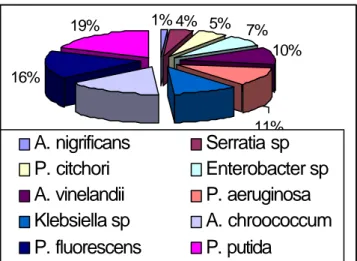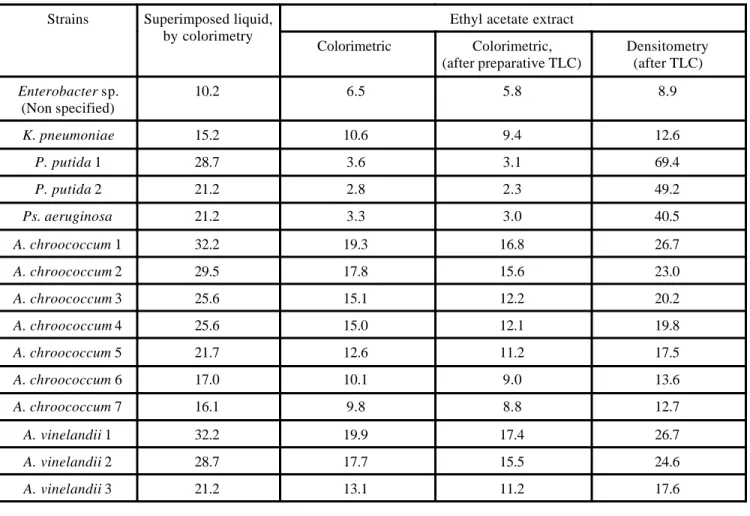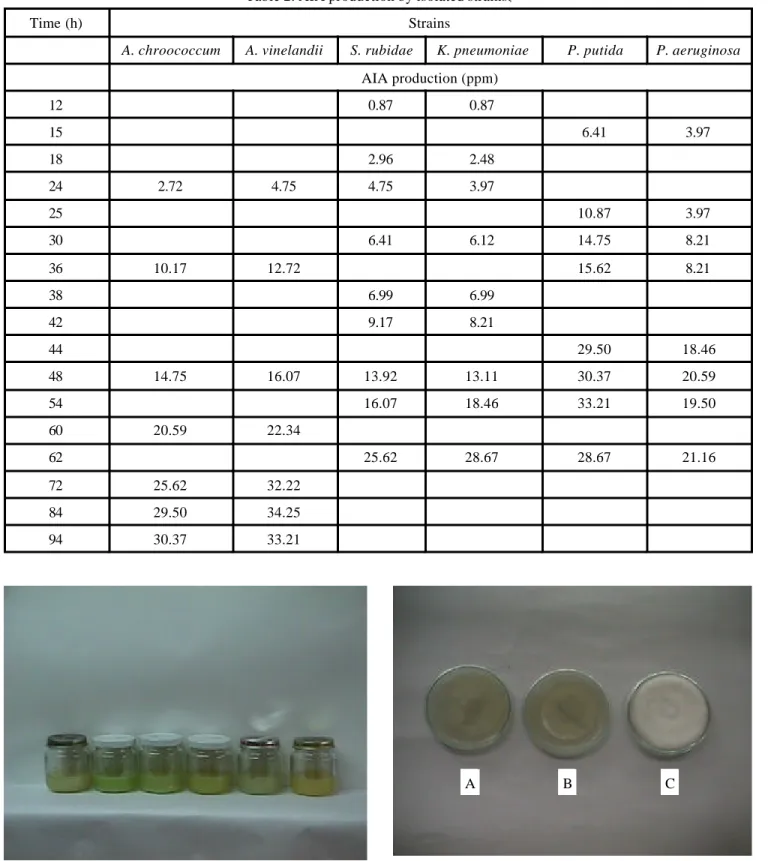ABSTRACT. Ethyl acetate extracts from superimposed liquid concentrated cell cultures of Azotobacter chroococcum, Azotobacter vinelandii, Pseudomonas aeruginosa, Pseudomonas putida, Serratia sp. and Kleb-siella pneumoniae strains, obtained from rhizosphere of rice cultivated in the Tolima region, Colombia S. A., have shown to be pr oducers of extra cellular indole -3-acetic acid (IAA) at concentrations from 3.5 mg/ mL to 32.2 mg/l. A. vinelandii, and K. pneumo niae yielded the highest concentrations. Pseudomonas sp. was found in vitro to antagonize the Phytophthora infestans, mainly by production of siderophores under low presence of iron. Colonization of hyphae and production of antibiotics were additional activities ob-served.
Key words: indole-3-acetic acid, siderophores, Azotobacter chroococcum, Azotobacter vinelandii, Pseudo-monas aeruginosa, PseudoPseudo-monas putida, Serratia sp., Klebsiella pneumoniae.
RESUMEN. Extractos concentrados de acetato de etilo de cultivos de cepas de Azotobacter chroococcum, Azotobacter vinelandii, Pseudomonas aeruginosa, Pseudomonas putida, Serratia sp. and Klebsiella pneumo-niae obtenidas de la rizósfera del arroz cultivado en la región de Tolima, Colombia S.A., han producido ácido indol-3-acético (IAA) a concentraciones de 3.5 mg/ml to 32.2 mg/l. A. vinelandii y K. pneumoniae produjo las más altas concentraciones. Pseudomonas sp. Se encontró que in vitro antagoniza a Phytopht-hora infestans, principalmente por la producción de sideróforos bajo bajas concentraciones de fierro. La colonización de hifas y producción de antibióticos fueron actividades adicionales observadas.
Palabras clave: ácido indol-3-acético, sideróforos, Azotobacter chroococcum, Azotobacter vinelandii, Pseu-domonas aeruginosa, PseuPseu-domonas putida, Serratia sp, Klebsiella pneumoniae.
Isolation of Enterobacteria,
Azotobacter
sp.
and
Pseudomonas
sp., Producers of Indole-3-Acetic Acid and Siderophores, from
Colombian Rice
Rhizosphere
M
ARÍAG
UINETHT
ORRES-R
UBIO,
1S
ANDRAA
STRIDV
ALENCIA-P
LATA,
1J
AIMEB
ERNAL-C
ASTILLO,
2*
P
ATRICIAM
ARTÍNEZ-N
IETO1Departamento de Microbiología,
1and Departamento de Química,
2Pontificia Universidad Javeriana,
Colombia. Carrera 7a # 43-82 Edificio Carlos Ortiz ofc. 201 Bogotá, Colombia S. A.
* Corresponding author: E mail jabernal@javeriana.edu.co Phone (571) 3208320 Ext. 4074 Fax (571) 2850503
INTRODUCTION
Some microorganisms of soil, like Azospirillum sp.,18
Enterobacter sp., Azotobacter sp., Pseudomonas sp.,9, 16
Klebsiella sp., Alcaligenes faecalis, Azoarcus sp., Serratia
sp., cyanobacteria and sulfur oxidizing bacteria have shown to encourage plant growth,1, 6 by promoting the out-break of secondary roots, acting as protectors against phy-topathogenic microorganisms via plant hormones release and siderophores.2, 8, 13, 3, 5 In this work some members of
Enterobacteriaceae, Azotobacter sp. and Pseudomonas sp. were isolated from the identified Colombian rice rhizosphere, with production in vitro of indole-3-acetic acid and siderophores evaluated by colorimetry, TLC, den-sitometry and bioassays.
MATERIALS AND METHODS
Sampling. Microorganisms were collected from rhizosphere of twenty rice plants, chosen using the zigzag technique in a large plantation (approximately 105 m2) in
Espinal region of Tolima, Colombia, S.A., after two months of planted.
Microorganisms isolation and identification. Sam-ples of 10 g of rhizosphere (roots and soil) were shaken with 90 ml of culture broth; tripticase soy was used for
Pseudomonas sp, EMB for Enterobacteria and Asbhy and Asbhy-benzoate solutions for Azotobacter sp. An aliquot of 1 ml from each broth was added to a selective medium to purify the bacteria. Identification of grown isolated colo-nies was based on morphologic, biochemical and culturing characteristics.
Strains and media conditions. Serratia sp. and Kleb-siella pneumoniae were grown in agar EMB (Oxoid),
Pseudomonas fluorecens and Pseudomonas putida in King B (BBL) and Azotobacter chrocoocum and Azotobacter vinelandii in agar Ashby and agar Ashby -benzoate, respec-tively.
Indole-3-acetic acid production. This was obtained from 3 days and 20°C cultures of Enterobacterias and
sp., in Ashby broth supplemented with 0.5% soy flour. Colorimetric analysis. After centrifugation (100 rpm. 20 min), the liquid portion of an aliquot of each broth was mixed with Salkowski reagent (2:1) and the developed (30 min) color was measured by spectroscopy at 530 nm.12 Concentrations were calculated from an adjusted calibra-tion curve. In separate experiments, quantitative spectro-scopic analysis was done, also at 530 nm, after isolation of IAA by TLC, scraping its colored spot and dissolution in methanol.
Thin layer chromatography. In a successful ap-proach, the concentrated (4:1) aliquots (100 ml) of the liq-uid portion of centrifuged sample of each broth were brought to pH 3.0 and extracted three times with ethyl ace-tate. The organic phase was concentrated to dryness and then diluted with 0.5 ml methanol. Application of this solu-tion on silica gel G plate (20 cm x 5 cm) was diluted as red band with mixture of chloroform-ethyl acetate-formic acid (5:3:2) and developed with Salkowiski reagent giving the correct Rf value (0.57).
Densitometry. This technique was used on TLC spots, to estimate the relative concentration.
Siderophores In vitro production. This was evaluated by Pseudomonas sp. antagonistic capacity against Phy-tophthora infestans strains. Pseudomonas sp. was grown in King B agar and King B agar modified with FeCl3 (1.36
ppm), on circled lines close to the border of the dish. Eight days before the same agar dishes had been spread at their center points with P. infestans. The dishes were left at 28° C, during 8 additional days and inhibition zones were measured.
Hyphae colonization and antagonistic capability.17
Supernatants resulted from cultures of Pseudomonas sp., left at 25°C during 5 days in King B broth with centrifuga-tion (100 rpm, 20 min) were spread on several Petri plates, each containing a strain of P. infestans in an agar medium and incubated at 25°C during eight days. The inhibition zones were measured and calculated as percentages. The antagonistic effect of Pseudomonas sp. was estimated as follow: On a plate containing a strain of P. infestans, grown around and close to the border during eight days at 25°C in agar – potato medium, bacteria were in line inocu-lated near the fungus and incubated again at 25°C and dur-ing additional eight days. The inhibition zone after meas-ured were calculated as percentages and compared to P. infestans grown in absence of bacteria.
RESULTS AND DISCUSSION
Bacteria in rhizosphere of Colombian rice. An evaluation of rice rhizosphere from Espinal, Tolima, Co-lombia, showed to included 69 bacteria; among them, 51% were Pseudomonas sp., mainly of species P. putida, P. aeruginosa, P. fluorescens and P. citchori; 26% were of genus Azotobacter sp., species, A.vinelandii, A.
chroococ-Klebsiella sp., Serratia sp., Enterobacter sp. These results, seen in Fig. 1, have some similarities with those found els ewhere for rhizosphere of maize.3 The aforesaid bacteria
have been recognized to possess plant growing promotion properties.4
Production of indole-3-acetic acid. All forty treated strains (15 Enterobacteria species, 19 Azotobacter sp. and 6 Pseudomonas sp.) in a culture medium containing soy flour as tryptophan source, not used before,produced IAA, as detected by the Salkowski reagent under colorimetry,12
in the range 3.5 mg/l to 32.2 mg/l. Fig. 2 shows four sam-ples of the attained solutions of this compound. The hig h-est concentrations of IAA was obtained from A. chrooco-cum, 1-7 (32.2 mg/l – 16.1 mg/l; A. vinelandii (32.2 mg/l – 21.2 mg/l); P. putida, 1-3 (28.7 mg/l – 14.8 mg/l); P. aeruginosa (21.2 mg/L) and K. pneumoniae (15.2 mg/l). Table 1 contains the IAA concentrations found in the
su-19% 1% 4% 5% 7%
10%
11% 11%
16%
16%
A. nigrificans
Serratia sp
P. citchori
Enterobacter sp
A. vinelandii
P. aeruginosa
Klebsiella sp
A. chroococcum
P. fluorescens
P. putida
Fig. 1. Percentage distribution of the isolated microbial population.
Strains Superimposed liquid, by colorimetry
Colorimetric Colorimetric, (after preparative TLC)
Densitometry (after TLC)
Enterobacter sp.
(Non specified)
10.2 6.5 5.8 8.9
K. pneumoniae 15.2 10.6 9.4 12.6
P. putida 1 28.7 3.6 3.1 69.4
P. putida 2 21.2 2.8 2.3 49.2
Ps. aeruginosa 21.2 3.3 3.0 40.5
A. chroococcum 1 32.2 19.3 16.8 26.7
A. chroococcum 2 29.5 17.8 15.6 23.0
A. chroococcum 3 25.6 15.1 12.2 20.2
A. chroococcum 4 25.6 15.0 12.1 19.8
A. chroococcum 5 21.7 12.6 11.2 17.5
A. chroococcum 6 17.0 10.1 9.0 13.6
A. chroococcum 7 16.1 9.8 8.8 12.7
A. vinelandii 1 32.2 19.9 17.4 26.7
A. vinelandii 2 28.7 17.7 15.5 24.6
A. vinelandii 3 21.2 13.1 11.2 17.6
Ethyl acetate extract
Table 1. Indole -3-acetic acid concentration found in superimposed liquid and in ethyl acetate extract derived from the cul-tures of the most productive species of some genus.
0 5 10 15 20 25 30 35
15 25 30 36 44 48 54 62
Time (h)
Concentration (ppm)
P. putida P. aeruginosa
Table 2. AIA production by isolated strains..
Time (h) Strains
A. chroococcum A. vinelandii S. rubidae K. pneumoniae P. putida P. aeruginosa
12 0.87 0.87
15 6.41 3.97
18 2.96 2.48
24 2.72 4.75 4.75 3.97
25 10.87 3.97
30 6.41 6.12 14.75 8.21
36 10.17 12.72 15.62 8.21
38 6.99 6.99
42 9.17 8.21
44 29.50 18.46
48 14.75 16.07 13.92 13.11 30.37 20.59
54 16.07 18.46 33.21 19.50
60 20.59 22.34
62 25.62 28.67 28.67 21.16
72 25.62 32.22
84 29.50 34.25
94 30.37 33.21
AIA production (ppm)
Fig. 5. Siderophores production by different species of
Pseudomonas
Fig. 6. Colonization and inhibition of Phytophthora in-festans (C) growth by P. aeruginosa (A) and P. putida 3 (B)
from cultures of some genus most productive species. Highest IAA concentrations were obtained at 75 h for A. chroococum and A. vinelandii; at 62 h for P.putida; at 48 h for P. aeruginosa and 60 h for K. pneumoniae, as esti-mated by production curves (concentration versus time, table 2 and fig. 3). Results for A. chroococum and A. vine-landii agree with those of Lee et al. (1970).11 IAA was is o-lated by TLC and detected as a red spot by the Salkowiski reagent (Rf: 0,57) as seen in Fig. 4. This technique also
indicated the presence of some IAA derivative compounds, whose Rf values agree with those of indole-3-acetamide11
and indole-3-lactic acid .7
Siderophores production. Production of colored siderophores by Pseudomonas sp.is known.15 Sideropho-res production by the Pseudomonasspecies, isolated from King B liquid medium free of FeCl3 can be seen in Fig. 5.
When a medium of King B agar was supplemented to 1.36 ppm of iron as FeCl3, siderophores production had no
rele-vant changes; however, inhibition percentage of P. in-festans growth by Pseudomonas sp. decreased substantially (from 94% to 75% with P. putida 2, from 100% to 57% with P. putida 3, from 95% to 68% with P. putida 1, from 98% to 78% with P. aeruginosa and from 74% to 66% with P. fluorescens). These important variations may be partially due to some involvement of pigments in inhibi-tion processes10,14 however, in the case of P. fluorescens 1, the appearance of antibiotics could be an important factor. Colonization of hyphae. Strains of P. aeruginosa, P. putida 3 and P. fluorescens 1, grown in King B broth and spread on hyphae of P. infestans, revealed good coloniza-tion and fungicide properties upon them, and therefore an-tagonistic17 capabilities (Fig. 6). Fungicide property was corroborated by the lack of growth of treated hyphae, while remnants of these were taken from the edge of the inhibition zone and incubated in PDA agar. Other
Pseudo-monas sp. showed fungistatic effects since only growth inhibition was observed which might be attributed to the accompanying siderophores of spread Pseudomonas sp. broths (Fig. 7). PDA agar cultures could not yield these pigments because of high concentration of iron in the me-dium.
The most abundant bacteria in rice rhizosphere, grown in the Espinal region, Tolima, Colombia, S.A., belonged to genus Pseudomonas sp. (51%), Azotobacter sp. (26%) and Enterobacteria (21%). All these microorganisms produce IAA when tryptophan is present in the medium. An ade-quate method to evaluate the relative abundance of the IAA was based upon TLC, followed by spectrophotometric analysis.
P. aeruginosa, P. putida 3 and P. fluorescens, in ab-sence of FeCl3, show biological control and antagonistic
activity against P. infestans and siderophores production. A technique to measure these antagonistic effects, based on inhibition zone width is provided. Antagonistic activities decreased when FeCl3 was present in the medium, sugges
t-ing that the siderophores play an important role.
REFERENCES
1. Arteca, R. 1996. Plant Growth Substances. Ed. Chap-man & Hall. New York. p. 850.
2. Amströn, B., A. Gustafsson, and B. Gerhardson. 1993. Characteristics of a plant deleterious rhizosphere pseu-domonadand its inhibitory metabolite (s). J. Appl. Bac-teriol. 74:20-28.
3. Bashan, Y., G. Holguin and R. Ferrera-Cerrato. 1996. Interacciones entre plantas y microorganismos benéfi-cos II. Bacterias asociativas de la rizósfera. Terra 14: 1-16.
4. Bashan, Y., G. Holguin and R. Ferrera-Cerrato. 1996. Interacciones entre plantas y microorganismos benéfi-cos III. Procedimientos para el aislamiento y caracteri-zación de hongos micorrizicos y rizobacterias promoto-ras de crecimiento en plantas. Terra 14:18-34.
5. Bull, C., C. Ishimaru and J. Loper. 1994. Two genomic regions involved in catechol siderophores production by Erwinia carotovora. Appl. Environ. Microbiol. 60: 662-669.
6. Burbano, H. 1994. La material orgánica del suelo en el contexto de una agricultura sostenible. Memorias del seminario “Fertilidad de suelos: Diagnóstico y Control. Sociedad Colombiana de Crecimiento de la Ciencia del Suelo. p. 188-217.
7. Fett, W., S. Osman and M. Dunn. 1987. Auxin produc-tion by plant-pathogenic Pseudomonas and Xhantomo-nas. Appl. Environ. Microbiol. 53:1839-1845.
8. Gamliel, A. and J. Katan. 1992. Influence of seed and root exudates on Fluorescent Pseudomonas and Fungi in solarized Soil. Ecol. Epidemiol. 82:320-327.
9. Gamliel, A. and J. Katan. 1992. Chemotaxis of fluores-cent Pseudomonas towards seed exudates and germi-Fig. 7. Inhibition of Phytophthora infestans by P. putida 2.
nating seeds in solarized soil. Ecol. Epidemiol. 82:328-332.
10. Hamdan, H., D. Weller and L. Thomashow. 1991. Relative importance of fluorescent siderophores and others factors in biological control by Pseudomonas fluorescens, 2-79 and M4-80R.
11. Lee, M., C. Breckenridge and R. Knowles. 1970. Effect of some culture conditions on the production of indole-3-acetic acid and a gibberellins-like substance by
Azotobacter vinelandii. Can. J. Microbiol. 16:1325-1330.
12. Loper, J. and M. Schroth. 1986. Influence of bacterial sources of indole-3-acetic acid on root elongation of sugar beet. Physiol. Biochem. 76:386-389.
13. Tien, T., M. Gaskins and D. Hubbel. 1979. Plant growth substances produced by Azospirillum brasilense
and their effect on the growth of Pearl Millet (Pennisetum americanum L.). Appl. Environ. Micro-biol. 37:1016-1024.
14. Weger, L., M. Cornelia, V.D. Vught, A. Wlijfjes, P. Baker, and B. Lugtenberg. 1987. Flagella of a plant-growth stimulating Pseudomonas fluorescens strain are
required for colonization of potato roots. J. Bacteriol. 169:2769-2773.
15. Weger, L., M. Cornelia, V.D. Vught, A. Wlijfjes, P. Baker, and B. Lugtenberg. 1986. Siderophores and outer membrane proteins of antagonistic plant-growth-stimulating, root-colonizing Pseudomonas sp. J. Bacte-riol. 165:585-594.
16. Weisbeek, P., N. Bitter, J. Leong, M. Koster, and J. D. Marugg. 1990. Genetics of iron uptake in plant growth-promoting Pseudomonas putida. WCS358. In Pseudo-monas: Biotransformations, Pathogenesis and Evolving Biotechnology. S. Silver, A. Chakrabarty, B. Iglewski and S. Kaplan (Ed.). American Society for Microbio l-ogy, Washington, D.C. 423 p.
17. Yang, C. H., J. A. Menge. and D. A. Cooksey. 1994. Mutations affecting hyphal colonization and pyover-dine production in Pseudomonas antagonistic toward
Phytophtora parasitica. Appl. Environ. Microbiol. 60:473-481.


